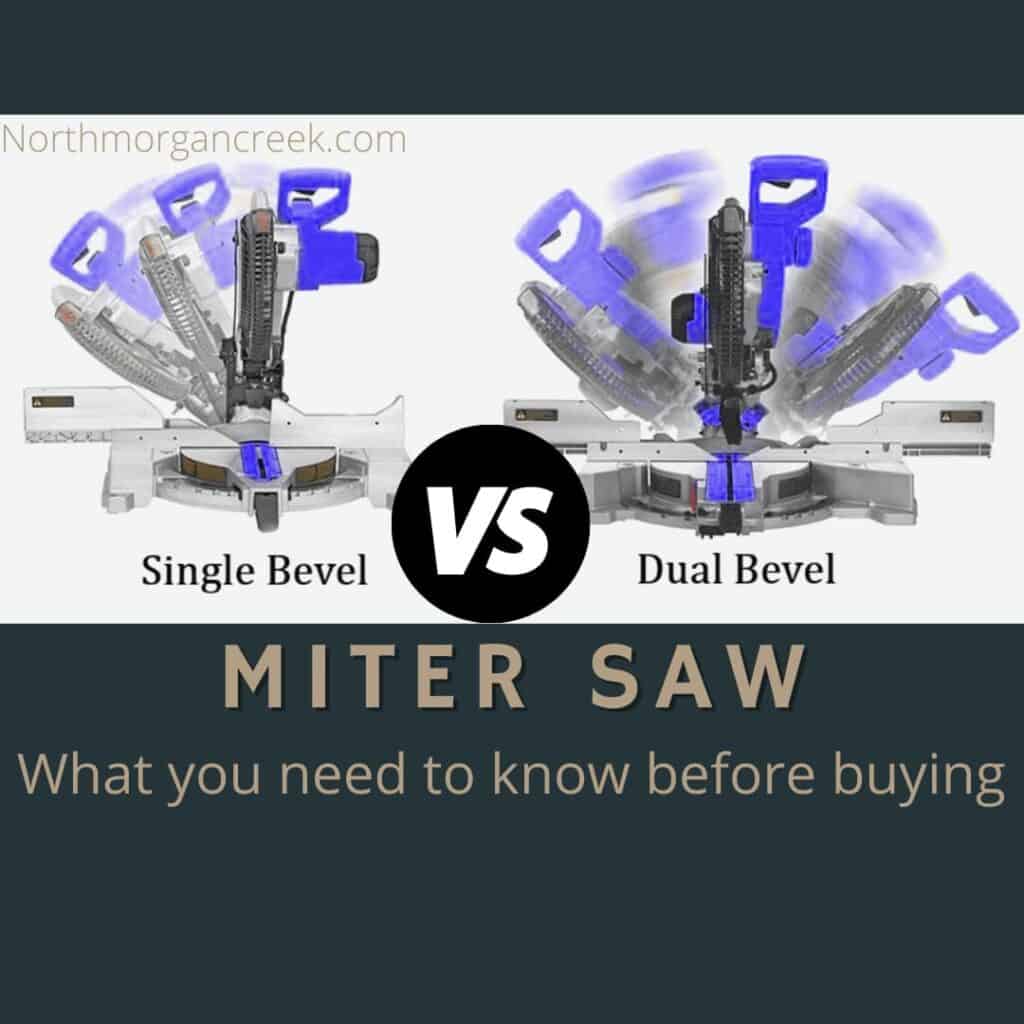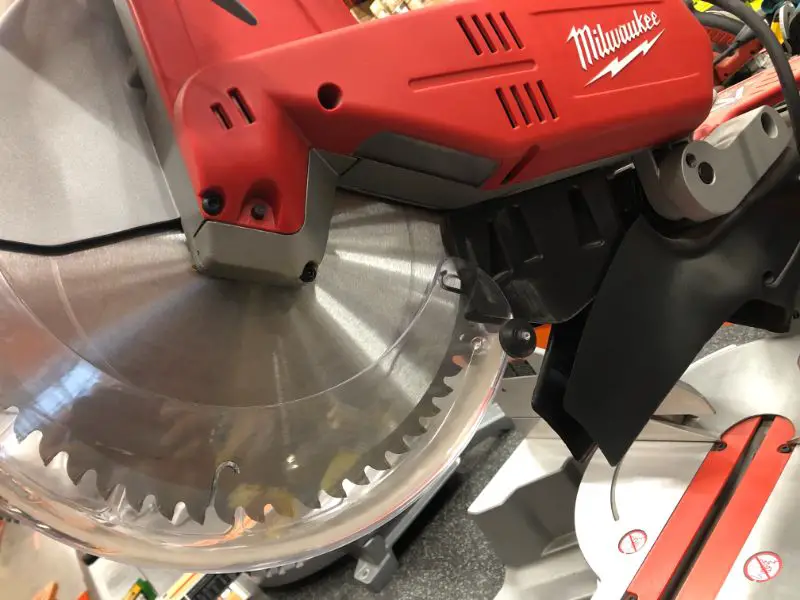I was working on a small piece of trim and I noticed that my cuts weren’t quite perfect. The corners weren’t square because my bevel cut was not straight. So I had to look online and see what reasons might make the miter saw bevel cut not straight.
After doing some reading and watching a few videos I started making some progress! I found that there’s a whole lot of reasons that might be causing the miter saw bevel cut to not be straight.
Quick solution! Many experts mention that a leading cause for this problem is not clamping the material down. Bevel cuts tend to pull the material towards the blade during the cut. Make sure you have a clamp when making a bevel cut!
Luckily, there’s also a lot of solutions to help us solve this problem. I figured that we might as well share what we found and what worked for us.
Below is a list of possible problems that I checked, and solutions for those problems. This might not be an exhaustive list, but it has most of the major issues that you’ll come across.
Let’s get to it!
Reasons Your Bevel Cut Isn’t Straight
First thing, is that there isn’t just one reason why your miter saw isn’t giving you straight bevel cuts. There’s a lot of possible causes for this problem. Even more confusing is that it might be a combination of two problems that aren’t noticeable by themselves.
These slight problems might team up and make the miter saw bevel cut not straight. So what are these problems? Well most experts are recommending that you check the 4 major parts of the miter saw.
The blade, fence, miter gauge and finally the bevel gauge are you most likely culprits.
4 problems making your miter saw bevel cuts not straight
First, the blade! Miter saw blades are flying around at a high rate of speed, this means that if the blade is damaged, warped or installed incorrectly you might have issues. The blade is the first thing that I would check when looking to troubleshoot this problem.
Second, the fence. The fence holds your material square so the blade can do its job. It’s hard to tell if your fence is out of line, but a minor issue here can really mess up a lot of cuts. I’d check the fence second!
Next, the miter gauge. While your miter gauge might not be an issue, if you’re making compound cuts you need to check it. Also, since you’re check the other parts of your miter saw, you may as well check the miter gauge while you’re at it!
You need to ensure that you gauges are in fact at the correct angle. Yes, you have some really nice presets on you gauges that tells you exactly where you need to set the saw.
But, these can sometimes get shifted, and make the miter saw bevel cut not straight. Ensuring everything is square and at the proper angles is important!
Lastly, the bevel gauge. We saved this one for last because it’s probably the first thing you would think to check.
Just like the miter gauge you need to ensure that the angles are really what the preset say. Don’t trust that the manufacturer got it perfect, and don’t expect your miter saw to always stay the same!
Ensure The Problem Is With The Bevel
As we mentioned above. There’s a few main reasons why you bevel cut might be out of whack. We recommend that you check each of these four main points and ensure that they’re in proper working order.
Start with the blade of the miter saw and begin the process of elimination. Checking the blade, then the fence, onto the miter gauge until you come to the bevel gauge.
What are we checking for? First and foremost, any obvious damage, warping or parts that need replacing. Maybe a screw on the fence has come loose and your material isn’t sitting flush on the fence. Well, that would be a very lucky thing to spot and fix!
Next check that your other cuts are working well. Start by making a straight 90 degree chop cut, then a miter cut. Once you’ve done that move onto a bevel cut, and finally a compound cut.
Compare the cuts from each type and see if you problem spans over all the cuts, or just one or two of them. This will help you narrow down the cause of the problem.
Checking the fence and blade are square, and checking the gauge against an angle gauge will help eliminate most of the possible causes.
Fixing A Miter Saw Problem
Hopefully with the above steps you were able to spot the problem! If you didn’t don’t fret, we still have more troubleshooting we can do!
We’re not going to go into detail on how to fix each problem, as each fix would be a story of its own. But, YouTube will have some great resources once you’ve diagnosed the problem.
Once you know what you need to fix, fixing the problem becomes much, much easier. If you still haven’t found the issue, the problem making your miter saw bevel cut not straight might be a more minor issue.
It could perhaps be the way you’re making cuts. Using a miter saw does take a little bit of skill, and a seasoned woodworker knows this!
Lastly, what degree of error is there in your bevel cut? Is it noticeable with the naked eye? Will all your guests be able to tell your trim was cut with a bad saw?
Miter saws, while accurate, are not designed to be perfect. Miter saws are designed to be rugged and make great cuts that give great results for trim, framing and other home improvement needs
If you need zero error and a miter saw isn’t doing it for you, consider moving to another tool. A table saw with a cross cut sled for bevel cuts will offer less error than with a miter saw can give you.
Making Better Bevel Cuts With Your Miter Saw
We’re not trying to point fingers here, honestly! But, a tool is only as good as the person using it. If you’re new to miter saws or just need a refresher, here’s some tips for getting more precise cuts.
First, and this might be the answer to your problem, only make cuts while the blade is at full speed! Don’t just turn the saw on and cut.
Let the blade fully speed up before you make contact with the wood. Giving the saw a few seconds to get up to speed will ensure the blade can easily make its way through the material.
Next, and this goes along with the first, don’t rush the blade. Once the blade is up to speed, let the blade do the work, firmly but gently allow the blade to make its way through the material. Rushing the blade will only increase tear out and issues with the cut.
Lastly, you need to use a clamp. Bevel cuts are notorious for having slight issues. The reason for this is because the way the saw is tilted.
Once the saw is in a position to make a bevel cut, the blade will want to pull the material in towards the blade as the cut is being made. If the material isn’t clamped down, the material will move mid-cut and make the miter saw bevel cut not straight.
Prevent Bad Bevel Cuts With Your Miter Saw
The old saying goes “An ounce of prevention is worth a pound of cure”. Miter saws can be rugged, but they still have some fine gauges that need to be taken care of.
Job sites and workshops are no stranger to having material bang around or heavy items falling. That’s why work boots and hard hats are the norm! Taking good care of your miter saw will go a long way to increasing its lifespan, but also in its precision.
When transporting your miter saw make sure you set it down gently, and strap it down so it doesn’t shift while driving. The last thing you want is for your tools to collide if you have to make a sudden stop!
Use it, don’t abuse it. Care for your miter saw
Make cuts with care, don’t rush the blade and only cut material with the proper blade. Use it with care!
Don’t slam the material on the fence. I’ve seen this before, a friend needed to chop some 2x4s to fit in a car, and didn’t need them to be any particular length.
They did this very quickly, but they were throwing the material around including when they placed it on the fence. Not only can this cause issues with you saw, it isn’t safe!
Lastly, maintain your saw. Doing simple maintenance, and removing built up dust and debris will go a long way to prevent you from having issues in the first place.


